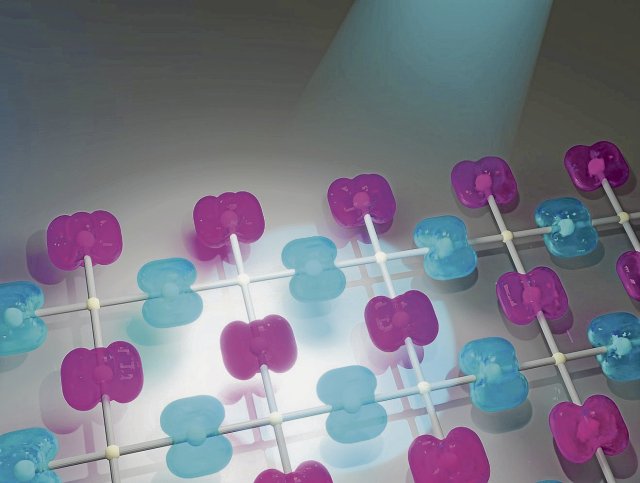In the altermagnetic crystal, the spin directions and the atomic shapes change.
Photo: Libor Šmejkal und Anna Birk Hellenes/JGU
Around 2,000 years ago people noticed and were amazed that even stones can sometimes be quite affectionate. Pliny the Elder reports of a shepherd whose shoenails were literally drawn to the ground in certain places. It was probably the iron ore known today as magnetite, which occurs naturally in the region and shows strong magnetism.
But while the effect of the magnets was easy to observe and they were used in pioneering ways, for example as a compass, the cause of the phenomenon was unclear for a long time.
Only with the advent of quantum mechanics could the “attractiveness” be explained. It turned out that the magnetism of a solid can be traced back to the properties of its atoms: Every electron has a “spin”, which can be imagined somewhat like the classical angular momentum, but which is a quantum mechanical property of the particle. The spin creates a magnetic field so that each electron acts as a small elementary magnet. In a solid, the atoms are in a regular or crystalline order and the elementary magnets align with the crystal lattice: If they are all parallel and point in the same direction, their small magnetic fields add up to a large one – and the solid appears “ferromagnetic”.
Without external magnetic field
In addition to the eponymous elemental iron (Latin: ferrum), well-known ferromagnetic materials include nickel, neodymium and numerous compounds. There are plenty of applications for ferromagnets – from small magnets on the refrigerator door to components in electric motors to magnetic data storage. In the case of hard disk drives, for example, the coating of the hard disk is magnetized in such a way that the information about the “magnetization pattern” can be saved and later read out again by scanning the magnetization. Each data point corresponds to a small magnet – which limits the storage density because the magnetic fields must not interfere with each other.
nd.DieWoche – our weekly newsletter

With our weekly newsletter nd.DieWoche look at the most important topics of the week and read them Highlights our Saturday edition on Friday. Get your free subscription here.
Another group is a little more individualistic: the antiferromagnets, which were first described by Louis Néel in the 1930s. Here, neighboring elementary magnets also align in parallel – but they always alternately point in the opposite direction. The magnetic moments cancel each other out and no external magnetic field results. Antiferromagnetism is energetically cheaper and therefore more stable and occurs much more frequently in nature than ferromagnetism. Many elements in particular from the group of transition metals, for example chromium and manganese and their oxides, show this property. Since antiferromagnets do not create a macroscopic magnetic field, there is the possibility that the materials could significantly increase the density of magnetic storage – although this is still the subject of ongoing research.
Connection of known properties
Scientists have now succeeded in experimentally proving a third variant of magnetism, which was theoretically predicted a few years ago. The phenomenon called “altermagnetism” combines properties of both ferromagnets and antiferromagnets. The elementary magnets align in opposite directions – completely antiferromagnetically – but this time the atoms in the crystal could also align themselves in such a way and always alternately that a current flowing through them experiences similar effects as is the case with ferromagnets. This could therefore also make alter magnetism extremely interesting for electronic applications.
Based on the theoretical work, alter magnetism probably wouldn’t even be particularly rare: more than 200 compounds have been identified as candidates for the effect. Only experimental proof has so far been difficult.
The physicists have now found what they are looking for in a so-called “photon emission experiment” on manganese telluride, which shows no external magnetic field. In the experiment, a material is irradiated with laser light in such a way that the photons can knock an electron out of its bond. The subsequent measurement of the electrons makes it possible to determine their spins and thus the order structure of the material. It was proven that the compound exhibits the characteristics of both a ferromagnet and an antiferromagnet. As the first magnet for old people, it is now attracting the interest of science and technology.
Become a member of the nd.Genossenschaft!
Since January 1, 2022, the »nd« will be published as an independent left-wing newspaper owned by the staff and readers. Be there and support media diversity and visible left-wing positions as a cooperative member. Fill out the membership form now.
More information on www.dasnd.de/genossenschaft
